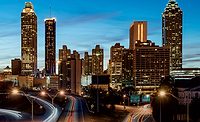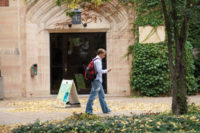George Street is a popular entertainment district in St. John’s, Newfoundland, with 22 bars, pubs and clubs in a two-block area. Not surprisingly, it is an area that keeps the local police busy.
“The chief of police decided to address the number of calls that we were getting from the George Street area,” says Sergeant Roy Hoskins. Although some of the establishments had surveillance cameras outside their building, the Royal Constabulary and the local government decided to turn to a police-controlled camera system. “We wanted the cameras to assist police officers in investigating any crimes, so we wanted something with the clearest images we could get with the technology available.”
St. John’s turned to Bosch to install a day/night camera system that would provide high quality images in low light conditions, as well as provide images that could distinguish individuals. The community went with an analog video stream from George Street to headquarters.
Despite only needing to provide surveillance to a two-block area, there were a surprising number of challenges to setting up the system. “We wanted to cover as much of the area as possible, as well as the alley that branched off the street,” Hoskins explains. He sized up the area to decide where to place the 12 cameras and came to the conclusion that the best spot was on the utility poles.
“One of our biggest hurdles was getting access to using the utility poles,” he adds. “We had to work with the utility company to allow us to place the cameras in high-voltage areas on the poles. Because it is a high-voltage area, only people who are qualified can work there, so we had to work out an agreement on how the cameras would be serviced.”
The police department also had to meet requirements of Canada’s privacy commissioner to ensure correct signage notifying people that there were security cameras in the area. Plus the cameras would be exposed to a number of different weather conditions. “In our area, we have a great flux in temperatures,” Hoskins says. “We wanted a camera with good environmental housing and heaters.” The one weather condition he found the cameras can’t solve is snow, which sticks to the dome of the camera. “But then it rains or the sun comes out and the snow disappears, so it works.”
The cameras have been in operation since May 2011, and Hoskins believes that is has solved a major outdoor security problem for his community. “It’s not the magic bullet that will solve every case, but it provides the information that assists the investigators in solving the case.”
The police of St. John’s only needed to provide security for a two-block area. Another city wanted a single system to be used that would monitor events, receive alerts of potential threats and suspicious activities and then rapidly implement action. The city was broken into zones, already equipped with security devices that generated an overload of information – so much information that it became difficult to control.
The solution was a multi-site incident management system with more than 30 PSIM C4 (command, control, communications, computer/intelligence center) stations. The system then integrates all of the city’s key safety and security functions into a single unified platform. More than 5000 security cameras were deployed. There is also full GPS integration with a 3D virtual view of city.
Outdoor Tips
Both examples focus on securing outdoor areas in a city environment, but the approaches are very different. Both examples also show that whenever you need to secure an outdoor area, whether it is a city street, a parking lot, a golf course, or the grounds outside a nuclear plant, every situation will be unique to the location and the environment, yet all situations share many of the same challenges.
Outdoor surveillance is tough because there are so many variables that aren’t controlled, explains Willem Ryan, senior product marketing manager with Bosch. Even though indoor security can be challenge, but you can always control lighting and the environment indoors. The opposite is true when dealing with the outdoors. Outdoors, you never know what the lighting is going to be from hour to hour, and then there are the night hours that need to have artificial lighting.
When securing a city street or a parking lot, the temptation is to use the lighting available. But that lighting is meant for safety, not for security surveillance and may not be a good mix for the camera.
You also have to factor in a combination of light sources, including natural and artificial, streetlamps, vehicle headlights and ambient lighting that will affect picture quality. Once coverage expectations are defined for a given surveillance area, an audit of the daily lighting conditions is required to determine the best imaging solution to meet defined expectations for your video surveillance system.
But then, sometimes there are situations where it is difficult to depend on lighting at all. In those cases, the solution may be thermal imaging cameras, says Andy Teich, president of FLIR. Instead of sensing light sources, Teich says, thermal imaging cameras sense heat. Thermal also works in greater distance than light, so it could be a better option in open, unlit spaces like golf courses, or in areas where the perimeter is almost impossible to secure by any other means.
For example, the Port of Portland services more than 800 vessel calls each year. With four marine terminals, the Port processes a diverse mix of cargo including bulk, breakbulk, containers and automobiles, with operations running day and night, year round. Any security system had to be prepared to handle all types of lighting conditions and all types of weather.
The Port has spent the last two years designing and implementing an impressive security upgrade. Some of these new security systems focused on the cargo and its containers. For example, the Optical Character Recognition system scans shipping container markings and matches these markings to their truck’s license plate, and Radiation Portal Monitors scan containers for abnormal levels of radiation that may betray the presence of a dirty bomb.
Other parts of the Port’s security upgrade involved the Terminal’s physical security. These included the installation of improved guardhouses, reinforced fencing, improved access control through the implementation of the Transportation Worker Identification Credential (TWIC) system and the integration of Forward Looking Infrared (FLIR) thermal imaging cameras.
Because FLIR cameras generate images from heat rather than light, the cameras were sure to work in any type of environmental condition, including total darkness or stormy weather.
The Port of Portland coupled the thermal cameras with a video analytics package, creating a virtual perimeter in areas that are otherwise almost impossible to secure physically, such as rail access points and the waterfront.
For example, trains come into the Terminal areas at all hours of night and day, so fencing them would be impractical, expensive and dangerous. This is an obvious vulnerability, because anyone could walk down the tracks and be inside Port property before the security team knew anything about it. With the thermal cameras, however, Port security can monitor rail access points 24-hours a day, and receive alarms whenever anyone crosses onto Port property.
However, John Romanowich, CEO, SightLogix, Inc., points out, a challenge for thermal cameras – in any outdoor area – occurs when objects such as buildings and parking lots that were heated during the daytime start to cool after sunset. At some point, they will cross over 98.6 degrees, becoming almost identical to the temperature of a person. This can leave gaps in coverage where thermal cameras will miss intruders, and it happens every day.
However, recent advancements in the sensitivity of thermal imagers, combined with sophisticated on-board image processing, now enable them to determine very fine temperature variations that reveal intruders even in the presence of thermal crossover, while presenting clearer thermal images regardless of conditions. In some cases, thermal cameras with the necessary processing can deliver images that approach black and white video quality
Sorting Out the Environment
City surveillance is becoming deployed more often. However, the environment is tough to monitor because of the sheer volume of information to digest, as well as the physical aspects of a dense concentration of buildings. For that reason, the physical characteristics of a facility are also very influential when selecting cameras. Aside from achieving adequate coverage of external areas of interest around your facility, the actual facility construction, landmark status and proximity to other businesses or residences may call for special surveillance measures.
The positioning of the camera has to be well-thought out, mentions Paul Bodell, senior executive of global business development with IQinVision. In areas with snowy winters having an eastern-facing camera could result in nothing but white light as the sunrise hits the landscape.
When installing an outdoor camera, Bodell adds, you also have to take into consideration what you want the camera to see. Is it general detail or high detail? At that point, selecting the right lens will determine the amount of detail and at what distance.
Two of Loyola University’s three Chicago-area campuses were involved in an extensive security upgrade. One of those campuses, the Lake Shore Campus, serves as residential and undergraduate campus with more than 40 buildings. The second campus, the Water Tower Campus, is in an urban environment, near Chicago’s Magnificent Mile. Needless to say, each campus had very different security needs.
Before the upgrade, the University had a patchwork security system comprised of analog cameras, VCRs, DVRs, different access control readers and a variety of access cards for students and faculty. The VCRs provided little useable video for ID purposes. A mandate came down from administration that the surveillance system at the Lake Shore Campus had to be upgraded.
The solution was a system with cameras that provided a number of important benefits, including plug and play functionality, power over the Ethernet, and network stability, according to a case study. Initially, 80 cameras were deployed around the campus. They’ve also been installed to monitor the perimeter of the campus to survey action on public throughways. This technology will also be used at the Water Tower Campus.
Traditionally, open areas are the hardest to protect with surveillance video, points out Scott Schafer, executive vice president of Arecont Vision. It would require many analog or VGA resolution cameras to cover a parking lot or park and provide detailed images. Fortunately, the development of megapixel cameras in higher and higher resolutions reduces the number of cameras needed to provide detailed images that will yield recognizable features such as license plate numbers and facial recognition.
Schafer’s approach to securing an outdoor space is to start the design with panoramic cameras as they are able to capture large areas as well as the security director’s attention. The needs and wants of the end user dictate the remainder of the design and layout. Most outdoor installations that take advantage of megapixel technology are a combination of panoramic cameras and camera/lens combinations at choke points.
The problem that border security and many outdoor security situations face is the power source. Getting electricity to more remote areas is difficult or, as in the case with the George Street surveillance, there will be restrictions. So many security providers are turning to wireless cameras or cameras that pull in their energy from the Ethernet connection.
When setting up a security system, Yaron Zussman, vice president of global accounts with DVTel, recommends considering the ease of maintenance and replacement of the equipment, as well as understanding that sometimes there will be false alarms with the equipment. That’s why it is so important to develop a good collaboration between the manufacturer, the integrator, and the end user to get the best out of your security system.
Intrusion Detection
One of the challenges in outdoor security, especially in more rural areas or in wide-open spaces, is being able to detect a real intruder from a random wild animal. For the people at Grouse Mountain Resort in Vancouver, B.C., however, the security system was necessary especially to keep track of the wildlife – specifically, two orphaned grizzly bears.
“We’ve taken the DVR camera technology and adapted it to research purposes,” explains Devin Manky, wildlife manager at Grouse Mountain Resort. The cameras are used for some security purposes, such as to make sure the people who come to watch the bears are safe, but mostly it the cameras keep check of the bears and their behavior.
In the summer months, there are five cameras in operation to watch the bears in a five-acre fenced-in space. In the winter, the bears hibernate in a man-made, pitch-black den. “In order not to disturb them, we needed a non-invasive way to monitor them, so we put in a pinhole camera with some infrared emitters. That hooks into the DVR as a way to record motion,” Manky says.
The outdoor cameras needed to be extremely durable to handle installation on a mountaintop. Manky admits that cost did factor into the final decision on the security system installed, particularly the costs and logistics of connecting the cameras to a network and to power in such a remote location.
Perhaps the biggest challenge – and one not usually faced in other outdoor security needs – wasn’t so much setting up the cameras inside the bears’ den, but trying to figure out how to keep the bears from playing with the camera equipment.
“Because the inside of the den is pitch black, we needed cameras with infrared,” Manky says. “Cameras with built-in infrared emitters were a couple of inches in diameter and were fairly large. Now, bears are very curious and they can smell something different. They found the cameras several times and proceeded to play with the cameras, and lick them. We have great footage of one instance of a camera in a bear’s mouth. It was still making infrared, so you could see the bear’s tongue and tonsils.”
That’s why Manky switched to a pinhole camera that is about the size of a penny and is flush with the wall. So far, the bears haven’t noticed it.
These cameras, and the unusual request to be able to stream the videos to a website – most security cameras footage isn’t meant for online use, Manky points out – have been so successful that Grouse Mountain Resort is planning to expand with more wireless cameras that show more angles of the bear habitat.
Of course, securing outdoor spaces doesn’t exclusively involve camera equipment. There will be areas where other forms of security, like x-ray scanners or metal detectors, are useful. A few such applications are outdoor venues like stadiums where anyone coming into the facility is scanned and parking garages where vehicles are screened. Another area of security is protecting open air spaces from attacks such as from a chemical weapon.
Always consider using a layered approach for outdoor security, because there is no silver bullet that will protect everything. The more technologies and options you use, the better your chances are at keeping outdoor spaces safe.






